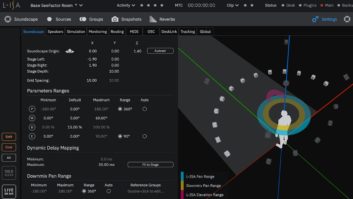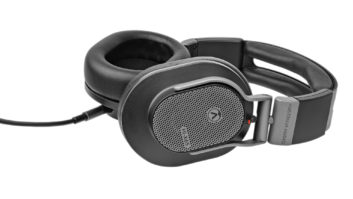
The Solo/Laptop card comes with a free set of plug-ins.
Whether Universal Audio is focused on developing analog gear or software emulations, the company has always been dedicated to sonic excellence. Its UAD system offers expertly crafted plug-in versions of the vintage analog gear the industry has come to love — outboard, classic consoles and more. The plugs run on UA’s DSP, which offers the advantage of not using resident (native) processing to achieve the processing outcome. Until recently, the UAD system used the PCIe bus of desktop computers, but now the UAD-2 Solo/Laptop accommodates the needs of laptop-based DAW users, attaching to the ExpressCard slot to achieve much higher bandwidth than FireWire or USB 2 can provide. This port has been available on high-end PC laptops manufactured in the past few years, as well as MacBook Pros.
In the Test Lab
Installation was a snap on my 3GHz MacBook Pro with 8 GB of RAM. The latest version of the accompanying software from the UA Website installed in a few minutes. Authorization meant downloading a small app from UA’s Website and running it — very simple. No iLok is necessary as the card is required to run the plug-ins and serves as security in and of itself.
The software control panel is inviting and makes it easy to flip through different settings to optimize the hardware. I can appreciate a plug-in manager where you can see which plug-ins are authorized, which ones you are demo’ing and which ones are available for trial. If you want more info about a plug-in — for example, the device on which the model is based — convenient buttons link directly to an online description. This makes it easy to figure out which tool will be right for the job. Every plug-in in the store is available for a 14-day, fully functional trial. The card also comes with a few free plug-ins to get you started.
Among the free plugs is the high-efficiency version of the 1176. This works much like the actual hardware version. The 1176’s compression is one of those unparalleled sounds that’s well-suited to a variety of applications, and as I turned the dials, I was pleased to hear its familiar tone faithfully represented. On an electric bass, it provided even, round bottom end while enhancing the bite of the strings’ attack. The included Pultec EQ plug-in performed admirably. A Pultec EQ across the two-bus has always been one of my favorite finishing touches in a pop mix, just before the last limiter. It’s great for adding an overall low-end bump and some edge on the top. The Pultec plug did this cleanly, emphasizing the overall harmonic content in these ranges without muddying the midrange frequencies.
I also tried some of the demo plug-ins. As far as vintage reverb goes, an EMT 140 plate is among the finest. Universal Audio studied three different plates from The Plant studios in Sausalito, Calif., and modeled them well. They sound warm, lush and open in the midrange, and there’s a nice top-end sheen. This really helped glue the elements of a mix together while maintaining detail. The newly modeled Empirical Labs FATSO limiter lends a unique squashed sound to a drum subgroup or the two-bus. In more extreme instances, the FATSO imparts enhanced harmonics through tasteful analog distortion. I was skeptical of a software model’s ability to convey those inherently analog sounds, yet the UAD version surpassed my expectations. The same was true of the Neve 88RS. Its distinctive tone and combination of EQ and compression pulls a vocal forward in a very distinctive way, enhancing the upper midrange and relieving the density in the lower midrange. It’s also great for unearthing synth pads lost in the battle of the midrange. No EQ or compressor I’ve ever heard has provided a comparable character, but the UAD-2’s 88RS truly delivered the same benefits as real Neve components.
On With the Performance
I used the Solo/Laptop with Logic 9 running on Mac OS X Snow Leopard; Logic 8 with a Harrison Mixbus virtual console; and Pro Tools M-Powered Version 7.4 running on Leopard. Aside from the MixBus, which crashed frequently while I was manipulating plug-ins (a problem Harrison has recognized and plans to correct in an update arriving soon), the performance was flawless. I like the small DSP Meter window, which doesn’t occupy much room on the screen. I was a bit disappointed with how quickly I could max out the processing power of the UAD-2 Solo/Laptop’s SHARC chip.

Select summary to visit site.
However, this made more sense when I tallied my plug-in count. I maxed out at four 88RSs, two 1176 SEs, two Pultec EQs, an LA-2A, a Moog Filter, an SSL Bus Compressor, a Plate 140, a UA RealVerb Pro and a Cooper Time Cube — a tall stack with 14 instantiations of the heartier plug-ins. That said, it would be nice if you could run additional UAD-2 plug-ins in RTAS or VST versions when the SHARC chip is used up while still necessitating the device itself for authorization. My quad-core internal processor had significant CPU headroom, and considering the fact that the MacBook Pro is the only laptop in the Mac family with the ExpressCard slot needed for this device, it seems that this might often be the case.
My only other issue was the considerable latency introduced by many of the UAD-2 plug-ins. Logic compensates automatically, but when trying to track a vocal overdub or a MIDI keyboard feeding a Logic instrument, I had to bypass some plug-ins for the sake of performance. Pro Tools M-Powered suffered the most because there is no automatic delay compensation, but UA offers a solution. Bundled with the UAD-2 Solo/Laptop is a third-party RTAS plug-in from Mellowmuse called ATA (Automatic Time Adjustment). You start by putting an instance of the plug-in on each track and the master fader. It compensates by playing a pulse through each track and measuring the round-trip delay. This certainly helped when using dynamic processors and it tightened up the Pro Tools/UAD-2 relationship overall, but when it came to time-based processors, the results were more unpredictable. Naturally, when you are deliberately inducing some amount of delay as an effect, the ATA has no way of knowing what you’re trying to do. I found that upping the dry output of the plug-in during pinging, and then switching back to 100 percent wet afterward seemed to help, though it was less convenient.
Is It Top Gear?
Altogether, I am pleased with the UAD-2 Solo/Laptop experience. It’s a valuable tool, particularly when access to high-end outboard gear is limited due to budget or the need for portability. The models offered provide excellent processing, and as far as plug-ins go are certainly among the most valuable tools I have encountered. Trying to run these powerful plugs would certainly take a toll on a native system, so the additional DSP is certainly welcome and now more portable than ever. There are no cables and no power supply, and the card sits neatly inside the machine with only a small protrusion. With only minor complaints and plenty of praise, it seems that Universal Audio has created a product that will fit into a variety of production environments.
Brandon Hickey is an engineer, educator and post-production consultant.







